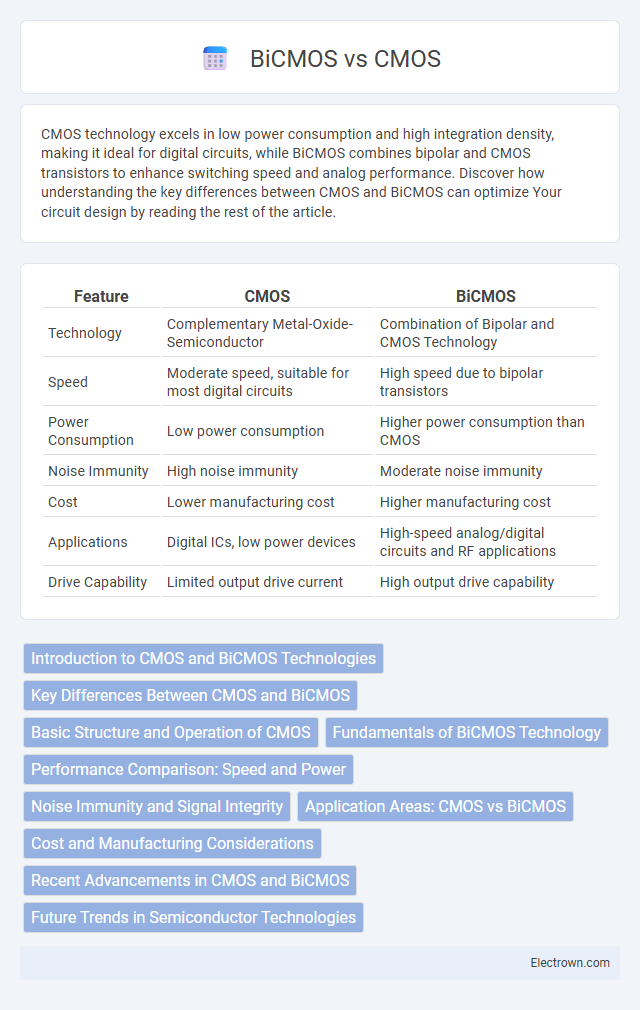CMOS technology excels in low power consumption and high integration density, making it ideal for digital circuits, while BiCMOS combines bipolar and CMOS transistors to enhance switching speed and analog performance. Discover how understanding the key differences between CMOS and BiCMOS can optimize Your circuit design by reading the rest of the article.
Table of Comparison
| Feature | CMOS | BiCMOS |
|---|---|---|
| Technology | Complementary Metal-Oxide-Semiconductor | Combination of Bipolar and CMOS Technology |
| Speed | Moderate speed, suitable for most digital circuits | High speed due to bipolar transistors |
| Power Consumption | Low power consumption | Higher power consumption than CMOS |
| Noise Immunity | High noise immunity | Moderate noise immunity |
| Cost | Lower manufacturing cost | Higher manufacturing cost |
| Applications | Digital ICs, low power devices | High-speed analog/digital circuits and RF applications |
| Drive Capability | Limited output drive current | High output drive capability |
Introduction to CMOS and BiCMOS Technologies
CMOS technology, known for low power consumption and high noise immunity, dominates digital circuit design, while BiCMOS technology integrates bipolar and CMOS transistors, offering both high speed and high current drive capabilities. BiCMOS is preferred for applications requiring high-frequency performance and analog/digital integration, combining the benefits of CMOS's efficiency with bipolar transistors' superior analog characteristics. Your choice between CMOS and BiCMOS depends on the specific performance requirements and power constraints of the intended electronic design.
Key Differences Between CMOS and BiCMOS
CMOS technology primarily utilizes complementary MOSFETs for low power consumption and high noise immunity, making it ideal for digital circuits. BiCMOS combines bipolar junction transistors with CMOS devices, offering high speed and high drive capability alongside low power benefits. Key differences include CMOS's efficient power usage versus BiCMOS's enhanced performance in analog and mixed-signal applications due to bipolar transistor integration.
Basic Structure and Operation of CMOS
CMOS (Complementary Metal-Oxide-Semiconductor) technology employs paired p-type and n-type MOSFETs that switch alternately to minimize power consumption during operation. The basic structure involves complementary pairs of transistors where one transistor conducts while the other is off, enabling efficient digital logic implementation with low static power dissipation. Its operation relies on the complementary action of the MOSFET pairs, ensuring that current flows only during switching transitions, which significantly reduces overall energy usage compared to BiCMOS circuits integrating bipolar transistors.
Fundamentals of BiCMOS Technology
BiCMOS technology integrates Bipolar Junction Transistor (BJT) and Complementary Metal-Oxide-Semiconductor (CMOS) devices on a single chip, combining the high-speed switching and high-current driving capabilities of BJTs with the low power consumption and high input impedance of CMOS transistors. This hybrid approach enables better analog performance and faster digital processing in mixed-signal circuits, making it ideal for applications requiring both precise analog control and efficient digital logic. By leveraging BiCMOS technology, your designs benefit from improved gain, increased speed, and enhanced noise margins compared to pure CMOS circuits.
Performance Comparison: Speed and Power
CMOS technology excels in low power consumption, making it ideal for battery-operated and energy-efficient applications, while BiCMOS offers superior speed performance due to the integration of bipolar transistors. BiCMOS circuits combine the high input impedance and low static power consumption of CMOS with the high current drive and fast switching capabilities of bipolar devices, enhancing overall speed without drastically increasing power consumption. In high-frequency and analog applications, BiCMOS outperforms CMOS by delivering faster switching speeds and better gain, though at the cost of somewhat higher power consumption compared to pure CMOS designs.
Noise Immunity and Signal Integrity
CMOS technology offers high noise immunity due to its low static power consumption and robust threshold voltage, making it suitable for digital circuits with less susceptibility to noise. BiCMOS combines CMOS's low power benefits with bipolar transistors' high gain and speed, enhancing signal integrity in analog and mixed-signal applications. The bipolar component in BiCMOS improves drive capability and reduces signal distortion, crucial for high-frequency and sensitive analog signal processing.
Application Areas: CMOS vs BiCMOS
CMOS technology dominates in digital integrated circuits due to its low power consumption and high density, making it ideal for microprocessors, memory chips, and smartphones. BiCMOS combines bipolar and CMOS transistors, offering high speed and better analog performance, which suits RF circuits, mixed-signal applications, and high-frequency communications. The choice between CMOS and BiCMOS depends on the need for power efficiency versus analog signal handling and switching speed in specific application areas.
Cost and Manufacturing Considerations
CMOS technology offers lower manufacturing costs due to its simpler process and higher yield rates, making it ideal for large-scale production of digital integrated circuits. BiCMOS combines bipolar and CMOS transistors, increasing complexity and fabrication expenses but enhancing performance in analog and mixed-signal applications. Your choice between CMOS and BiCMOS should factor in budget constraints and the specific performance requirements of your design.
Recent Advancements in CMOS and BiCMOS
Recent advancements in CMOS technology focus on enhancing power efficiency and scaling down transistor size to sub-5nm nodes, leveraging materials such as high-k dielectrics and gate-all-around (GAA) architectures. BiCMOS developments emphasize integrating high-speed bipolar transistors with CMOS logic for mixed-signal applications, improving analog performance and reducing parasitic capacitances. Emerging applications in 5G and AI accelerators drive innovation in both CMOS and BiCMOS platforms, targeting higher frequency operation and lower noise characteristics.
Future Trends in Semiconductor Technologies
Future trends in semiconductor technologies emphasize the integration of CMOS and BiCMOS processes to enhance performance in mixed-signal and high-frequency applications. Advanced BiCMOS technologies incorporate scaled CMOS transistors with bipolar junction transistors (BJTs) to achieve superior speed, low power consumption, and improved analog capabilities. Emerging sectors such as 5G communications, automotive radar, and IoT devices increasingly rely on BiCMOS solutions for balanced digital-analog circuit performance alongside CMOS scaling advancements.
CMOS vs BiCMOS Infographic

 electrown.com
electrown.com